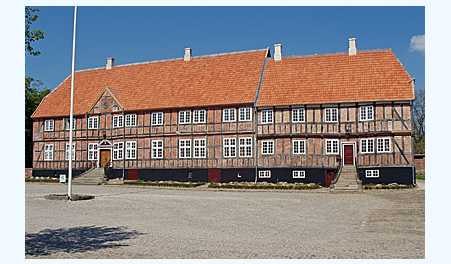
Lyngbygård
The west part of 'Lyngbygaard' is a beautiful example of a half-timbered house. Steep steps lead to the entrence, which has wooden pilastre.
In the hall a well-preserved stairway leads the visitors up to both bed-and guest rooms on the first floor. If you go through the gardening room you reach the landowner's room, which extend the whole building. Behind that room, the dining room is placed.
The well-proportioned rooms have preserved the beautiful Dutch doors, with beautifull brass mountings. Among the iron stoves the Norwegian one must be drawn special attention to, because of its rococo decorations. The kitchen section of the manor house, in 1876 had a four-sided tower build. If you take a closer look at the basement, one notoce that the western part is arched and much older than the east section.
The external walls is build of granite boulders and the low and wide barrel vault with groins over the windows was build in mediaeval large bricks. In the middle of the basement stands a four-sided substructure, which carry the great brick fireplace in the hall.
The manor house of 'Lyngbygaard' does not belong to the oldest manor houses in Denmark. Just after the Reformation 'Lyngbygaard' is mentioned as a manor farm with tenant farms. Mr. Johan Arent Althalt, who died in 1766, had the eastern part of the manor house build in 1755, according to an inscription over the kitchen door. His widow, who was a very busy woman, added much to the manor house. She had the western part of the manor house build in 1775.
In the year 1826 Mr. Johannes Friis bought ' Lyngbygaard'. Shortly after he resigned as captain (of the horse) at the Aarhus Garrison, and he bacame an inveterate landowner. But shortly after he had taken over the manor house of 'Lyngbygaard', it burnt down. In the year 1828 he had the manor house rebuild. Later he started to improve the farming. His son later specialized in dairy farming.
In the year 1903 his heirs sold the farm to Mr. Frederik Lagoni. He was a very good farmer and economist. He had two new cowsheds build.He also had the old big barn brought up to date. In the year 1917 engineer H.R.Angelo bought the manor house. He laid out a large vegetable- and orchard garden as well as many flowerbeds.
'Lyngbygaard' is co-owner of the hotel and inn at Aarslev, which is near by. The park is open to the public to a small entent, according to previous arrangement with the owner.